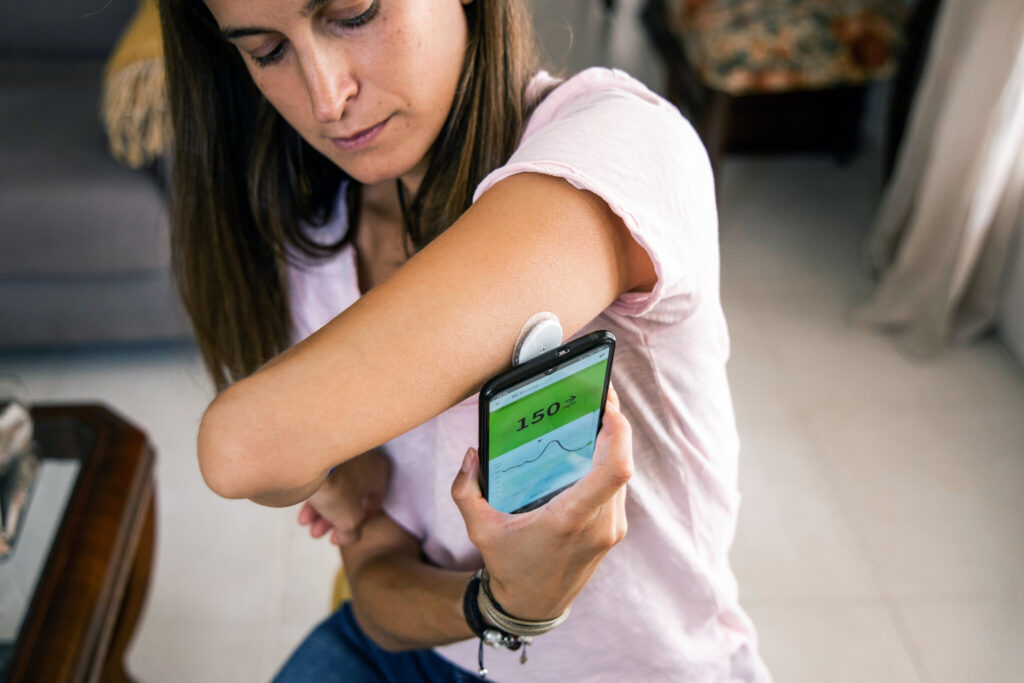Self-Management with Telehealth and CGM Integration
A comprehensive approach to diabetes care, combining telehealth services with continuous glucose monitoring (CGM) technology, has proven to be a transformative method for improving outcomes in both type 1 and type 2 diabetes. Recent research findings, published in JAMA Network Open, underscore the positive impact of this approach on patient outcomes.1
Background:
There is a growing body of evidence supporting the potential success of remote diabetes care and the CGM Integration technology. In response to adoption challenges, such as geographical limitations and limited access to specialized care, researchers initiated an assessment of a model designed to overcome these barriers for living with diabetes of type 1 or type 2, depending on the case.
Tip: Please fill out this form to determine whether or not you or a friend are eligible for Continuous Glucose Monitors and, Also learn about Blood Glucose Levels
Methods:
Between August 24, 2020, and May 26, 2022, a study known as the Virtual Diabetes Specialty Clinic (VDiSC) was conducted to evaluate the effectiveness and feasibility of establishing a virtual endocrinology clinic for comprehensive diabetes care. Participants were recruited through CVS Health Clinical Trial Services and referrals from primary care and endocrinology clinics. Eligible adults had either type 1 or type 2 diabetes and were using either an insulin pump or multiple daily injections of insulin.
Study Design:
Participants who were not already using CGMs underwent an initial study phase, during which they utilized a blinded Dexcom G6 pro-CGM to gather baseline data. Over the subsequent 26-week follow-up period, participants received unblinded Dexcom G6 sensors and completed three remote training sessions covering CGM initiation, the utilization of data visualization tools, and personalized CGM use.
Read Guide about Wegovy Dosage Guide: The Best Way For Weight Loss
Outcomes:
The primary efficacy outcomes included CGM usage, CGM metrics for hypoglycemia (<54 mg/dL and <70 mg/dL), hyperglycemia (>180 mg/dL and >250 mg/dL), and time spent in the range of 70 mg/dL to 180 mg/dL. Additionally, mean glucose levels, glycemic variability, HbA1c values, and participant-reported outcomes were measured.
Results:
The study included a total of 234 participants, with 160 having type 1 diabetes (T2D n=74). The average participant age was 47±14 years, with 53% being women, and a median diabetes duration of 20 years.
In the type 1 diabetes group, the mean participant age was 44±14 years (58% women), and the median diabetes duration was 23 years. Of the participants, 45% used an insulin pump, 55% used multiple daily injections, and 29% were already using a CGM at the beginning of the study.
Must Read About: Blood glucose monitoring in non-ICU settings
Over the 6-month period, median CGM usage was 96% (interquartile range [IQR], 91%-98%), which remained consistent during both 3-month follow-up periods. HbA1c levels decreased from 7.8% at baseline to 7.1% at month 3 and 7.1% at month 6 (mean change from baseline to 6 months, -0.6%). Time spent in the target range increased from 50% at baseline to 61% at 6 months (mean change, 11%). Other CGM metrics, indicative of hyperglycemia, showed similar improvements.
After the planned training sessions, the median number of additional follow-up contacts was 8 per participant (IQR, 6-10). These interactions included video training sessions, telephone calls, texts, or emails (80%, 9%, 6%, and 5%, respectively).
On the 6-month questionnaire, nearly all participants reported that using a CGM had significantly improved their diabetes management. The majority either strongly agreed or agreed that their experience with the virtual endocrinology clinic had led to better diabetes management.
The participant-reported outcomes indicated a decrease in the Diabetes Distress Scale score (mean change from baseline, -0.3) and a reduction in the score on the Hypoglycemia Fear Survey worry subscale (mean change from baseline, -2.9).
Discussion:
The type 2 diabetes cohort had a mean age of 55±12 years (42% women) and a median diabetes duration of 19 years. At the start of the study, 73 participants in this group were using multiple daily insulin injections, and none were using CGMs.
Median CGM usage over 6 months was 94%, consistent during both 3-month periods. HbA1c levels decreased from 8.1% at baseline to 7.1% at 3 months and remained at 7.1% at 6 months (mean change from baseline to 6 months, -1.0%).
Time in the target range increased from 48% at baseline to 66% at follow-up, with an 18% mean change. Mean glucose levels were 199 mg/dL at baseline and 166 mg/dL at follow-up, resulting in a mean change of -33 mg/dL.
The median number of follow-up contacts was 8 (IQR, 6-11), which included video training sessions, telephone calls, emails, and texts for 74%, 13%, 8%, and 5% of participants, respectively.
All participants who responded to the 6-month questionnaire expressed that CGM use had significantly contributed to their diabetes management. Eighty-five percent agreed that working with the virtual clinic had positively impacted their diabetes management.
Similar to the type 1 diabetes group, both the Diabetes Distress Scale score and the Hypoglycemia Fear Survey worry subscale decreased over the study period.
Must Read About Rising Sugar-Sweetened Beverage Consumption
Conclusion:
It is essential to acknowledge certain limitations of this study, including the predominantly White racial makeup of the cohort and the high rate of private insurance coverage, which may restrict the generalizability of the findings to individuals of different racial backgrounds and those with limited access to care.
The researchers concluded that the results highlight the clinical benefits associated with the implementation of a comprehensive care model that includes diabetes education. This model of care has the potential to reach a large portion of patients with diabetes, promote the adoption of diabetes technology, and enhance glucose control.


